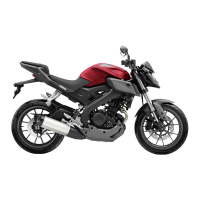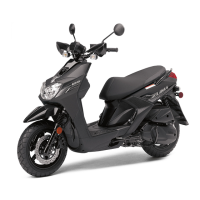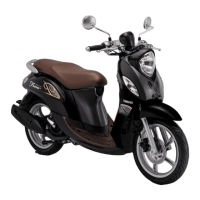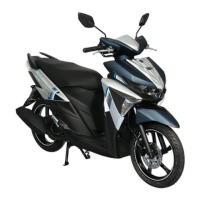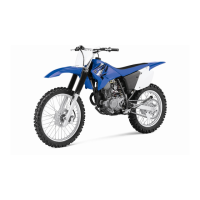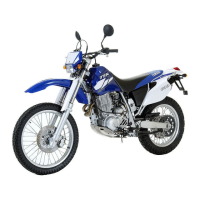Do you have a question about the Yamaha TTR 125 2020 and is the answer not in the manual?
Details on warning labels, emission control information, and tire specifications on the vehicle.
Owner's responsibilities, training, pre-operation checks, and safe riding practices for accident prevention.
Safety regarding operator experience, posture, alcohol, protective gear, and carbon monoxide hazards.
Guidelines for safe use of accessories and potential risks associated with modifications.
Safety checks for tires and proper procedures for transporting the motorcycle securely.
Identification of main parts visible from the left side of the motorcycle.
Identification of main parts visible from the right side of the motorcycle.
Identification and location of all motorcycle controls and instrument panel elements.
Explanation of the main switch's ON and OFF positions for controlling the electrical system.
Operation of clutch lever, shift pedal, engine stop button, and start switch for vehicle control.
How to use the brake lever, brake pedal, and fuel tank cap for vehicle operation.
Safe handling of gasoline, recommended fuel type, and tank capacity details.
Operation of the fuel cock positions and inspection of the fuel tank breather hose.
Instructions for using the starter (choke) knob and the kickstarter for engine ignition.
Procedures for removing the seat and adjusting the front fork's spring preload.
How to adjust the shock absorber's spring preload, rebound, and compression damping.
Operation of the sidestand and the starting circuit cut-off system for safe operation.
Procedures to check the functionality of the starting circuit cut-off system.
Guidelines for the initial break-in period to ensure engine durability and performance.
Step-by-step instructions for starting the engine from cold and warm states.
How to shift gears, accelerate, and decelerate for optimal riding and control.
Safe procedures for parking the motorcycle, including engine shutdown and positioning.
Periodic maintenance schedule for emission control system components.
Comprehensive chart for general maintenance tasks and lubrication intervals.
Instructions for removing and reinstalling body panels for access to internal components.
Procedure for checking the spark plug's condition, gap, and installation torque.
Steps to check the engine oil level and ensure it is within the specified range.
Guide for cleaning the air filter element and checking associated hoses.
Procedure for cleaning the spark arrester to maintain exhaust system efficiency.
Procedures for adjusting the engine's idling speed and general carburetor checks.
Adjusting throttle grip free play and checking valve clearance for optimal engine performance.
Critical checks for tire pressure, tread depth, condition, and wear indicators.
Checks for spoke wheels, including cracks, looseness, and balancing.
How to measure and adjust the clutch lever's free play for proper engagement.
Adjusting brake lever free play and brake pedal height/free play for braking control.
Procedures for checking front brake pads and rear brake shoes for wear.
How to check the brake fluid level and replenish if necessary, including fluid type.
Procedures for changing brake fluid and checking/adjusting drive chain slack.
Steps for cleaning and lubricating the drive chain to prevent wear and ensure smooth operation.
How to check and lubricate the pivots for brake and clutch levers.
Procedures for checking the sidestand operation and the condition/operation of the front fork.
Checking steering bearings and front/rear wheel bearings for play and smooth operation.
Procedures for replacing fuses and maintaining the battery, including charging.
Steps for removing and installing the front wheel, including safety precautions.
Steps for removing and installing the rear wheel, including safety precautions.
Guidance for diagnosing and resolving common operational problems with the motorcycle.
A flowchart for diagnosing engine starting issues related to fuel, battery, ignition, and compression.
General advice on washing the vehicle for appearance and performance.
Specific steps and precautions for washing the motorcycle, including after-wash care.
Recommendations for storing the motorcycle, including short-term and long-term procedures.
Comprehensive list of dimensions, weight, engine, fuel, and drivetrain specifications.
Recording essential vehicle identification numbers for registration and parts ordering.
How to record the key identification number for future reference and key ordering.
Information regarding federal laws prohibiting tampering with noise control systems.
A log to record scheduled maintenance and services performed by authorized dealers.
Explanation of the Yamaha limited warranty, coverage, exclusions, and customer obligations.
Information on optional extended service plans for continued protection after the limited warranty.
| Displacement | 124 cc |
|---|---|
| Bore x Stroke | 54.0 mm x 54.0 mm |
| Compression Ratio | 10.0:1 |
| Ignition | CDI |
| Transmission | 5-speed |
| Final Drive | Chain |
| Rear Brake | Drum |
| Front Tire | 70/100-19 |
| Rear Tire | 90/100-16 |
| Fuel Capacity | 1.6 gal |
| Width | 31.3 in |
| Ground Clearance | 11.8 in |
| Engine Type | Air-cooled, 4-stroke, SOHC, 2-valve |
| Front Suspension | Telescopic fork; 7.1-in travel |
| Rear Suspension | Single shock; 6.6-in travel |
| Front Brake | Disc |
| Seat Height | 31.7 in |



